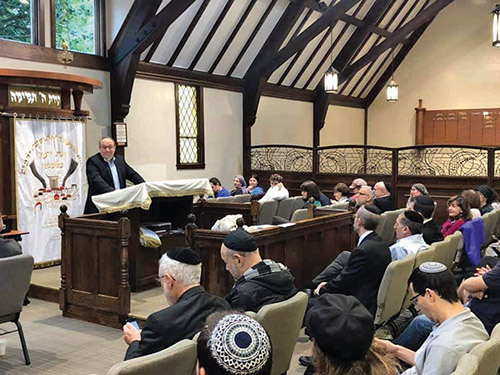



Atonement for a community’s sins and the 13 principles of divine mercy, the centerpieces of Selichot and the Yom Kippur liturgy, were delved into on multiple levels at the Rabbinical Council of Bergen County’s Kinus Teshuva, held the Sunday before Yom Kippur. The event, held communally for the first time, was organized by the RCBC’s current president, Rabbi Kenny Schiowitz, at his shul, Congregation Shaare Tefillah, in Teaneck. The morning event was attended by community members as well as half a dozen of the community’s rabbis.
Rabbi Schiowitz said he hoped the morning would be spent together communally learning Torah, using the opportunity of the Aseret Yemei Teshuva (Ten Days of Repentance) to discuss the issues relevant to the season as a cohesive group. “Even beyond our specific mistakes, this is a time to grow and to strengthen our relationship with Hakadosh Baruch Hu, on an individual level, and also to come together as a community,” he said.
Giving three 20-minute mini-shiurim were three Teaneck super-teachers: Rabbi Yaakov Neuburger, of Congregation Beth Abraham, Dean Rachel Friedman of the learning program Lamdeinu, based in Congregation Beth Aaron, and Rabbi Nathaniel Helfgot, of Congregation Netivot Shalom.
Leading off was Rabbi Neuburger, who discussed Hashem’s very great capacity for forgiveness, which can be modeled by people, to forgive others. “Our truth, our most basic understanding of ourselves, is chesed. The great truth is that without God’s kindness the world could not exist,” he said. Rabbi Neuburger explained that the Ribbono Shel Olam (Master of the Universe)’s 13 attributes, formed as part of a new covenant with Moshe Rabbenu in the aftermath of the Golden Calf, were a new way that Hashem taught Moshe to intercede with Hashem for communal forgiveness, and that the words are by no means an incantation or something that should roll off the lips as part of Selichot. “These attributes are among the most important prayers that Hashem gave us.
“He is teaching us how to turn to Hakadosh Baruch Hu and ask Him to show mercy, the way He taught Moshe to do, and how to give this over to the generations and teach them how to pray,” said Rabbi Neuburger.
“How do we actually achieve kaparah (atonement)?” asked Dean Friedman. She explained the ritual purification aspect that the kohen gadol went through by sacrificing two goats, one of which was killed as part of the altar sacrifice, and the other that was suffused with a confession of the sins of the community by the kohen gadol and sent out in the wilderness, a physical manifestation of purification from sins of the year—the original “scapegoat.”
“So, to truly achieve kaparah, there have to be two things that happen: a real, physical price, a ransom, like the goat that is physically sacrificed. And the second, we have to go through a cleansing, a confessional reflection, where we resolve to cast off or ‘fess up,’ and make it right,” Friedman said.
As the final speaker, Rabbi Helfgot addressed what was at stake theologically in the aftermath of the Golden Calf. “Hashem was ready to destroy us, but Moshe Rabbenu intercedes, thus creating a new nation.” He also compared the action by Am Yisrael in the aftermath of the Golden Calf as similar to the situation following Tisha B’Av, when the community was plunged into mourning as the Temples were destroyed. “Both are similar in that the Jewish people take the actions of aveilut (mourning). “The response of Bnei Yisrael is reacting to the absence, of the pullback, of the Shechinah, the divine presence
“It was the mourning and the true desire to be with God; they did not resign themselves to the absence of God in the camp,” he said. Through the tempered language of the 13 Attributes of Divine Mercy, the second luchot (tablets), were given with a rewriting of the language around “our zealous, jealous God.”
“We were given a term—teshuva: God is not just a vessel of power because He will seek you out. It is a statement that we deserve to be close to Hashem, and the culmination of the 13 attributes is the kiddush habrit, of a new covenant between Hashem and the Jewish people.”
With three mini-shiurim on such a high level enjoyed so early in the morning, attendees left the kinus feeling refreshed at witnessing such immense scholarship, and felt all the better prepared to address their personal supplications to Hashem on Yom Kippur.
By Elizabeth Kratz
�










